 W
WAstronomer Copernicus, or Conversations with God is a painting by the Polish artist Jan Matejko completed in 1873, in the collection of the Jagiellonian University, Kraków. It depicts Nicolaus Copernicus observing the heavens from a balcony in a tower with the cathedral in Frombork in the background. The canvas was purchased from a private owner by public subscription in Poland and hangs in the aula of the Collegium Novum of the University. Matejko produced this 1872 artwork as part of a series of paintings intended to capture and represent key moments in the history of Poland to inspire the public.
 W
WThe Bohemian is a painting by William-Adolphe Bouguereau completed in 1890. It depicts a barefooted young woman sitting on a concrete bench on the south bank of the Seine across from Notre Dame de Paris resting a violin in her lap. Her right arm is resting on her thigh while the palm of her left hand is pressed down on her left knee so that she does not lean on the violin. Her hands are clasped with the fingers pointing forward while her shoulders are wrapped in a shawl dyed maroon and light green, and she is wearing a gray dress that extends to her ankles. The bow of the violin has been stuck through diagonally under the fingerboard. To her right is a maple tree.
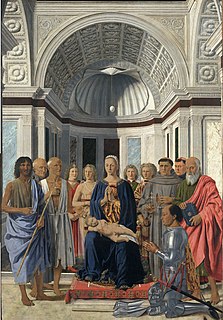 W
WThe Brera Madonna is a painting by the Italian Renaissance master Piero della Francesca, executed in 1472–1474. It is housed in the Pinacoteca di Brera of Milan, where it was deposited by Napoleon.
 W
WCapriccio of the City of London is an early 18th century oil painting made by the Dutch Griffier family, who became well known in England. Jan Griffier and his children, Jan and Robert, created the landscape.
 W
WThe Cathedral (Katedrála) is an abstract painting created by Czech artist František Kupka in 1912–13. The medium is oil on canvas, and the painting’s dimensions are 180 × 150 cm. The painting is a part of the permanent Jan and Meda Mládek collection of Museum Kampa in Prague, Czech Republic. This painting is one of a series of abstract works that Kupka termed Vertical and Diagonal Planes. Vertical lines, running the entire length of the canvas are intersected by diagonal lines to form rectilinear shapes of various sizes. The diagonal lines run from the top left to the bottom right and from the top right to the bottom left of the painting. These rectilinear shapes are composed of blocks of black, white, and a range of blue, red, purple, gray, and brown color. The large black space between the two clusters of the shapes, and the arching of the top of the right cluster, brings to the viewer’s mind two stained glass windows illuminated by light in a dark cathedral.
 W
WCharles of Bourbon Visiting St Peter's Basilica is a painting by Giovanni Paolo Pannini, commissioned by its subject Charles of Bourbon in 1746 and completed later that year. It was part of the same commission as the same artist's Charles of Bourbon Visiting Pope Benedict XIV at the Coffee House del Quirinale and both works are now in the National Museum of Capodimonte in Naples.
 W
WThe Church at Auvers is an oil painting created by Dutch post-impressionist artist Vincent van Gogh in June 1890 which now hangs in the Musée d'Orsay in Paris, France.
 W
WThe Church at Noisy-le-Roi, Autumn Effect or The Bell-Tower at Noisy-le-Roi, Autumn Effect is an Impressionist painting by Alfred Sisley.
 W
WChurch Pew with Worshippers is a watercolor created in September-October 1882 by Vincent van Gogh. A sketch of the painting was included in a letter van Gogh sent to his brother Theo that mentions the work.
 W
WCongregation Leaving the Reformed Church at Nuenen is an early painting by Vincent van Gogh, made in early 1884 and modified in late 1885. It is displayed at the Van Gogh Museum in Amsterdam.
 W
WThe Coronation of Napoleon is a painting completed in 1807 by Jacques-Louis David, the official painter of Napoleon, depicting the coronation of Napoleon I at Notre-Dame de Paris. The painting has imposing dimensions, as it is almost 10 metres (33 ft) wide by a little over 6 metres (20 ft) tall and was completed in the medium of oil painting. The work is on display at the Louvre Museum in Paris.
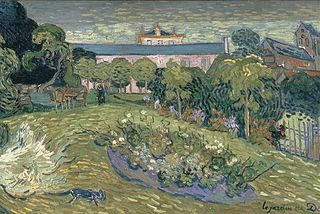 W
WDaubigny's Garden, painted three times by Vincent van Gogh, depicts the enclosed garden of Charles-François Daubigny, a painter whom Van Gogh admired throughout his life.
 W
WThe Delaware Tercentenary half dollar is a commemorative fifty-cent piece struck by the United States Bureau of the Mint to commemorate the 300th anniversary of the first successful European settlement in Delaware. The obverse features the Swedish ship Kalmar Nyckel, which brought early settlers to Delaware, and the reverse depicts Old Swedes Church, claimed to be the oldest Protestant church in the United States still in use as a place of worship. While the coins are dated "1936" on the obverse and the reverse also has the dual date of "1638" and "1938", the coins were actually struck in 1937.
 W
WDresden From the Right Bank of the Elbe Above the Augustus Bridge is an oil on canvas by the Italian urban landscape painter Bernardo Bellotto. Painted in 1747, it depicts the view of Dresden from the right bank of the River Elbe, including the Dresden Frauenkirche, the Dresden Cathedral, and the Augustus Bridge. One year later, he painted another piece titled Dresden From the Right Bank of the Elbe Below the Augustus Bridge, looking in the other direction from below the Augustus Bridge. Both of the paintings are in the permanent collection of the Gemäldegalerie Alte Meister. The paintings have proved invaluable in rebuilding parts of the city that were destroyed during World War II.
 W
WDresden From the Right Bank of the Elbe Below the Augustus Bridge is an oil on canvas by the Italian urban landscape painter Bernardo Bellotto. Painted in 1748, it depicts the view of Dresden from the right bank of the River Elbe, including the Dresden Frauenkirche, the Dresden Cathedral, and the Augustus Bridge. One year earlier, he painted another piece titled Dresden From the Right Bank of the Elbe Above the Augustus Bridge, looking in the other direction from above the Augustus Bridge. Both of the paintings are in the permanent collection of the Gemäldegalerie Alte Meister. The paintings have proved invaluable in rebuilding parts of the city that were destroyed during the World War II.
 W
WGothic Cathedral by a River is an 1813 painting by Karl Friedrich Schinkel. It shows an imaginary Gothic cathedral on an island in a river - Schinkel later became a noted proponent of neo-Gothic architecture. It is now in the Alte Nationalgalerie in Berlin.
 W
WLe Grand Canal is an oil on canvas painting by French Impressionist painter Claude Monet (1840–1926). It is one of six paintings looking down the Grand Canal towards the Salute church. This Grand Canal series is in turn part of a larger series of paintings of Venice which Monet undertook during 1908 on his only visit to the city. The artist is generally regarded by art historians as being at the peak of his powers at this period. The paintings were begun en plein air and completed in France.
 W
WThe Headless Horseman Pursuing Ichabod Crane (1858) is a painting by American artist John Quidor, depicting a scene from Washington Irving's 1820 short story "The Legend of Sleepy Hollow".
 W
WThe Holy Kinship is a circa 1495 oil on panel painting of Holy Kinship by the workshop of the renaissance artist Geertgen tot Sint Jans in the collection of the Rijksmuseum.
 W
WThe House of the Deaf Woman and the Belfry at Eragny is an 1886 oil painting by French artist Camille Pissarro, located in the Indianapolis Museum of Art, which is in Indianapolis, Indiana. It is a view of Pissarro's neighbor's yard in Eragny, created during his brief period of experimentation with pointillism.
 W
WThe Indian Church is a 1929 painting by Canadian artist Emily Carr. Group of Seven artist Lawren Harris bought the painting to showcase it in his dining room, and called it Carr's best work. In 1930, the work was shown in the Fifth Annual Exhibition of Canadian Art organised by the National Gallery of Canada. In 1938, the painting was chosen for an exhibition titled A Century of Canadian Art, at the Tate Gallery. The exhibition was described by Vincent Massey as "a most representative showing of Canadian painting and sculpture, including all schools and all periods." It is considered a "transitional" painting because it reflects the transition of Carr's artistic work from purely depicting Native Art to shifting her focus toward the land.
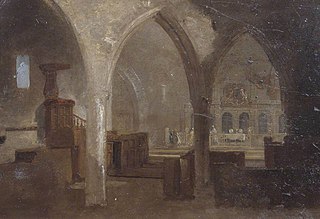 W
WInterior of a Gothic Church is a painting by J.M.W. Turner, painted c. 1797.
 W
WInterior of a Romanesque Church is a painting by J.M.W. Turner, painted c. 1795–1800.
In 2007, the United States Mint released a gold five-dollar commemorative coin which commemorates the 400th year after the founding of Jamestown. Surcharges from the sale of the Jamestown commemorative were donated to Jamestown-Yorktown Foundation of the Commonwealth of Virginia, the Secretary of the Interior and the Association for the Preservation of Virginia Antiquities to support programs that promote the understanding of the legacies of Jamestown.
 W
WLandscape with a Church at Twilight is an oil painting created in 1883 by Vincent van Gogh.
 W
WA Landscape with a Ruined Castle and a Church is an oil on canvas painting by the Dutch landscape painter Jacob van Ruisdael. It is an example of Dutch Golden Age painting and is now in the collection of the National Gallery.
 W
WMadonna in the Church is a small oil panel by the early Netherlandish painter Jan van Eyck. Probably executed between c. 1438–1440, it depicts the Virgin Mary holding the Child Jesus in a Gothic cathedral. Mary is presented as Queen of Heaven wearing a jewel-studded crown, cradling a playful child Christ who gazes at her and grips the neckline of her red dress in a manner that recalls the 13th-century Byzantine tradition of the Eleusa icon. Tracery in the arch at the rear of the nave contains wooden carvings depicting episodes from Mary's life, while a faux bois sculpture in a niche shows her holding the child in a similar pose. Erwin Panofsky sees the painting composed as if the main figures in the panel are intended to be the sculptures come to life. In a doorway to the right, two angels sing psalms from a hymn book. Like other Byzantine depictions of the Madonna, van Eyck depicts a monumental Mary, unrealistically large compared to her surroundings. The panel contains closely observed beams of light flooding through the cathedral's windows. It illuminates the interior before culminating in two pools on the floor. The light has symbolic significance, alluding simultaneously to Mary's virginal purity and God's ethereal presence.
 W
WThe Madonna of Chancellor Rolin is an oil painting by the Early Netherlandish master Jan van Eyck, dating from around 1435. It is kept in the Musée du Louvre, Paris, and was commissioned by Nicolas Rolin, aged 60, chancellor of the Duchy of Burgundy, whose votive portrait takes up the left side of the picture, for his parish church, Notre-Dame-du-Chastel in Autun, where it remained until the church burnt down in 1793. After a period in Autun Cathedral, it was moved to the Louvre in 1805.
 W
WThe Marble Steps Leading to the Church of Santa Maria in Aracoeli in Rome is a painting by the Danish painter, C. W. Eckersberg. It was painted in 1814–1816.
 W
WLa Mariée is a 1950 painting on canvas, measuring 68×53 cm, by Russian-French artist Marc Chagall. It is held in a private collection in Japan.
 W
WMedieval City on a River is an 1815 oil on canvas painting by the Prussian architect/artist Karl Friedrich Schinkel which is now in the collection of the Alte Nationalgalerie, Berlin.
 W
WThe Moret Church series of some dozen oil paintings was executed in 1893/94 by the English Impressionist artist Alfred Sisley. The church building depicted in each of the paintings is the Church of Notre-Dame in the village of Moret-sur-Loing, Seine-et-Marne, France, where Sisley had elected to see out his days until his death in 1899.
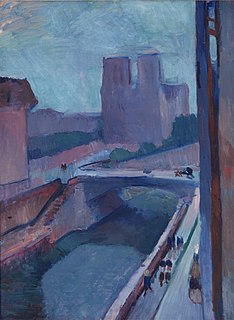 W
WNotre-Dame, une fin d'après-midi is a painting by Henri Matisse from 1902. Its somber coloration is typical of Matisse's works executed between the end of 1901 and the end of 1903, a period of personal difficulties for the artist. This episode has been called Matisse's Dark Period.
 W
WOld Church Tower at Nuenen are names given to several oil paintings and drawings created in 1884 and 1885 by Vincent van Gogh. Most reflect the way the 12th-century church looked in its better days when its spire was intact and its foundation formidable. The spire was demolished in 1792 and the church tower was in the process of being torn down and sold for scrap as Van Gogh made the paintings.
 W
WThe Parsonage Garden at Nuenen, alternatively named The Parsonage Garden at Nuenen in Spring or Spring Garden, is an early oil painting by 19th-century Dutch post-Impressionist painter Vincent van Gogh, created in May 1884 while he was living with his parents in Nuenen. Van Gogh made several drawings and oil paintings of the surrounding gardens and the garden façade of the parsonage.
 W
WThe Quai Saint-Michel and Notre-Dame is a 1901 oil on canvas painting by the French artist Maximilien Luce. Luce was part of the Neo-Impressionist movement between 1887 and 1897 and used the technique of employing separate dabs of color (divisionism), for the painting, which was one of ten he undertook of Notre Dame de Paris. The Musée d'Orsay in Paris, which holds the image as of 2015, notes that this was painted by Luce when he was moving from his Neo-Impressionist period to his later Populist period. The Musée d'Orsay obtained the picture in 1981.
 W
WThe Rouen Cathedral series was painted in the 1890s by French impressionist Claude Monet. The paintings in the series each capture the façade of the Rouen Cathedral at different times of the day and year and reflect changes in its appearance under different lighting conditions.
 W
WSalem is a 1908 painting by the English painter Sydney Curnow Vosper, depicting a scene within Capel Salem, a Baptist Chapel in Pentre Gwynfryn, Gwynedd, Wales. It is noteworthy as a depiction of Welsh piety, the traditional Welsh national costume, and for a contentious belief that the devil is depicted within it. Mass reproductions throughout the early and mid 20th century ensured the image became famous throughout Britain.
 W
WSalisbury Cathedral from the Bishop's Grounds is an 1823 landscape painting by the nineteenth-century landscape painter John Constable (1776–1837). This image of Salisbury Cathedral, one of England's most famous medieval churches, is one of his most celebrated works, and was commissioned by one of his closest friends, John Fisher, The Bishop of Salisbury. The 1823 version of the painting has been in the collection of the Victoria & Albert Museum in London, since its bequest in 1857.
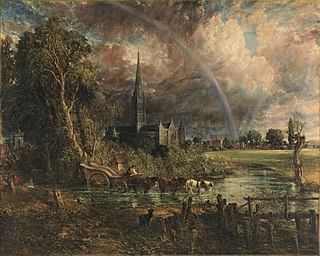 W
WSalisbury Cathedral from the Meadows was painted by John Constable in 1831, one year after the death of his wife, Maria. It is currently on display in London, at Tate Britain, in the Clore gallery. He later added nine lines from The Seasons by the eighteenth-century poet James Thomson that reveal the painting's meaning: That the rainbow is a symbol of hope after a storm that follows on the death of the young Amelia in the arms of her lover Celadon. Constable exhibited this painting at the Royal Academy in 1831, but continued working on it during 1833 and 1834.
 W
WClaude Monet painted a series of paintings of the island-monastery of San Giorgio Maggiore in Venice. They were begun in 1908 during the artist's only visit to the city. One of the best known is San Giorgio Maggiore at Dusk, which exists in two versions.
 W
WSaint-Georges majeur au crépuscule refers to an Impressionist painting by Claude Monet, which exists in more than one version. It forms part of a series of views of the monastery-island of San Giorgio Maggiore. This series is in turn part of a larger series of views of Venice which Monet began in 1908 during his only visit there.
 W
WScene in a Ruined Chapel is a 19th century painting by Fleury François Richard, now in the Musée des Beaux-Arts de Lyon.
 W
WSelf-Portrait with Seven Fingers is an oil painting by Belarusian painter Marc Chagall, painted in 1913 in France. This oil on canvas is a self-portrait in which the artist represents himself painting a reduced version of Of Russia, of Donkeys and Others, with seven fingers on one hand. It is kept as part of the Chagall collection at the Stedelijk Museum Amsterdam, in Amsterdam, Netherlands.
 W
WThe Seven Sacraments Altarpiece is a fixed-wing triptych by the Early Netherlandish artist Rogier van der Weyden and his workshop. It was painted from 1445 to 1450, probably for a church in Poligny, and is now in the Royal Museum of Fine Arts, Antwerp. It depicts the seven sacraments of the Roman Catholic Church. On the left panel are baptism, confirmation and confession and on the right hand panel the ordination of a priest, marriage and the last rites.
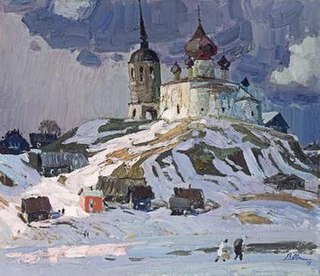 W
WSpring is on the way is a painting by Vladimir Ivanovich Ovchinnikov, Russian painter, who lived and worked in Leningrad, member of the Leningrad branch of Union of Artists of Russian Federation, regarded as one of the leading representatives of the Leningrad School of Painting, most famous for his landscape paintings.
 W
WSaint Jerome in the Wilderness is an unfinished painting by Italian Renaissance artist Leonardo da Vinci, dated c. 1480–1490. The composition of the painting has been drafted in monochrome onto the primed wooden panel. At an unknown date after Leonardo's death, the panel was cut into five pieces before eventually being restored into its original form. Created during Leonardo's last years in Florence, or first years in Milan, the work is now in the Vatican Museums.
 W
WThe Starry Night is an oil on canvas painting by Dutch Post-Impressionist painter Vincent van Gogh. Painted in June 1889, it depicts the view from the east-facing window of his asylum room at Saint-Rémy-de-Provence, just before sunrise, with the addition of an imaginary village. It has been in the permanent collection of the Museum of Modern Art in New York City since 1941, acquired through the Lillie P. Bliss Bequest. Widely regarded as Van Gogh's magnum opus, The Starry Night is one of the most recognized paintings in Western art.
 W
WView of Haarlem with Bleaching Fields is an oil on canvas painting by Dutch painter Jacob van Ruisdael. It is an example of Dutch Golden Age painting and is now in the collection of the Kunsthaus Zürich.
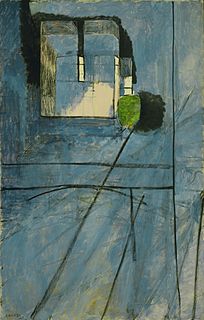 W
WView of Notre-Dame is an oil painting by Henri Matisse from 1914.